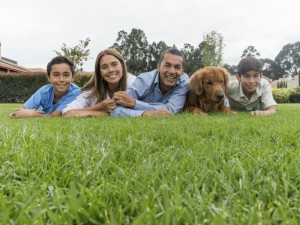Latest Posts
- Have a purpose when backyardingAugust 5 2021
- Study: Time outside alters our microbiomeAugust 4 2021
- Happy National Mutt Day from Mo-MoJuly 27 2021
- New home? Avoid these common mistakes in your yard.July 26 2021
- Infographic: Plan a backyard staycation this summerJuly 22 2021
Categories
Archive
June 28th
4 reasons to celebrate your yard this July 4th

The all-American holiday, July 4th, is just around the corner. And while you’re celebrating Independence Day with your friends and family, TurfMutt encourages you to also celebrate the all-American yard.
You see, your yard is not just about aesthetics. It also serves important functions, both for your family’s health and lifestyle and for the environment.
Living landscapes–including lawns comprised of turfgrass–offer places for children and pets to play and for the entire family to enjoy the outdoors. (That’s especially important for July 4th holiday weekend!)
Numerous studies have shown the benefits of green space to health, including improved mood, increased fitness levels, stress reduction and more. Additionally, turfgrass addresses a host of environmental issues.
Here are the top 4 environmental benefits of grass, in honor of July 4th!
Capture & Cleanse Rainwater
Grassy areas mitigate storm water runoff. They slow down and absorb runoff, while also cleansing water of impurities and dust.
Cool Heat Islands & Homes
Turfgrass dissipates the heat island effect. Remarkably, studies have shown that lawns can be 31 degrees cooler than asphalt and 20 degrees cooler than bare soil. But without grass and other plantings to reduce the heat island effect, communities will only get hotter. And your home cooling bills? Expect them to go up when green space is reduced!
Produce Oxygen & Sequester Carbon
Grass is an important carbon sink and oxygen producer. In fact, turfgrass is the largest carbon sink–natural systems that trap the greenhouse gas carbon dioxide from the atmosphere–in the country. Grasses remove about six tons of carbon dioxide per acre, per year from the atmosphere. Without grass, the carbon sequestration processes won’t occur, and your carbon footprint will grow bigger. Grass also plays a vital role in capturing dust, smoke particles and other pollutants that harm people. Without grass, these pollutants will remain in the air we breathe, resulting in more “code red” air quality days.
Provide Food & Shelter for Wildlife
Grasses, trees, shrubs and other plant life provide food and habitat for birds and small mammals. Insects, spiders and worms live among the grass blades and below the surface in the turf. Without a living landscape, food sources for birds and small mammals will quickly vanish. Xeriscaping or hardscaping forces common backyard animals to forage for food elsewhere. If we eliminate turfgrass from urban and suburban life, birds and wildlife will lose critical habitat.
Remember, the outdoors starts at your backdoor! Be a responsible citizen not by ripping out your lawn, but instead by putting the right plants in the right place and using water wisely.
Get more tips and information at LivingLandscapesMatter.com.





